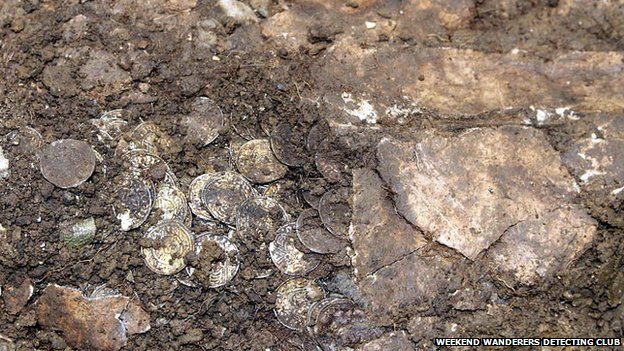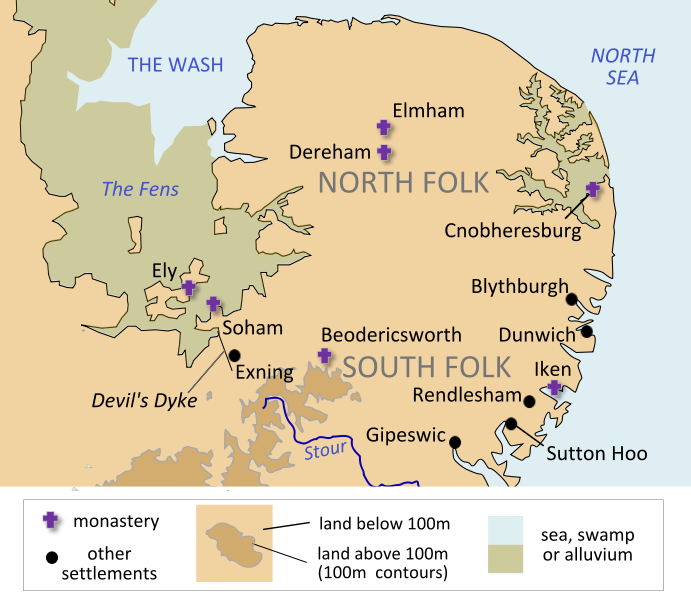Have you ever wanted to get rich quick? Long before Nigerian spammers were in on the act there was the art of metal-detecting. Often metal-detecting enthusiasts are derided as being a little bit odd and depicted as spending their lives wondering around barren fields with not much to show for it but then one of them discovers a lost treasure and spends the rest of their lives still being the subject of jealousy the rest of us.
The largest UK hoard of Anglo Saxon treasure was found in a field near Lichfield in Staffordshire in July 2009, by metal detector enthusiast Terry Herbert. His 7th Century hoard of 1,600 items including sword pommels, helmet parts and processional crosses was valued at £3.285m!
It was announced yesterday that Paul Coleman from the Weekend Wanderers Detecting Club discovered more than 5,000 coins buried inside a lead bucket two feet under a field near Aylesbury. The discovered hoard contains treasures dating back to the 11th Century – the late Anglo Saxon, early Norman period.
Mr Coleman, from Southampton, was taking part in a dig in the Padbury (just a days walk from the old Buckingham mint) area on 21 December when he found the 5,251 coins depicting the heads of kings Ethelred the Unready and Canute. Many of the coins are in absolute mint condition.

Metal detecting for treasure is a relatively cheap hobby and obviously comes with the chance that you might even make some money out of it. You can’t just metal detect anywhere and then start digging holes randomly around the countryside. Technically you need a licence and when I say technically, it’s more of that you do need a licence. However they are easily and cheaply obtainable. All the coast around the entire U.K. between the high tide and low tide marks belong to The Crown Estates or the Queen to you and me. If you wouldn’t dream of digging up Buckingham Palace gardens then think twice of treasure hunting around the coast or indeed any national park or public area as one way or the other it belongs to a council or government.
Like Mr. Coleman, you could try your luck around the countryside but you really should get permission from the land-owner first. It’s not likely they will object and if you find any treasures on their land then obviously you both have to share it out between you but make sure you agree this before you strike gold as if not, legally all treasure belongs to the landowner! If you do find something important then it is highly recommended you call in the local archaeologist and then a coroner within 14 days of discovery.
With thousands of years of history your treasure could be anything from an unexploded WW2 bomb to a collection of jewellery, coins, treasures, weapons or personal and military gear belonging to an untold number of groups of people. Treasure can often turn up in totally unexpected areas as settlements and roads move or totally disappear over the centuries or even millennia.
Once you have found some goodies worth keeping then you can’t quite count on making it rich. Previously the Coroner would decide whether the treasures had been buried for its owner to return to or accidentally lost. The wrong verdict could be tough news for the metal sector enthusiast as then the treasure could be taken by The Crown or in practice a museum. These days, this is less likely to happen but it is still a possibility.
If the hoard is declared to be treasure then the Coroner will value it and the finder must sell it to any museum who is interested in it. Otherwise the finder can keep the treasure or sell it for the best price available.
There are still numerous treasure hoards that we know about that have yet to be discovered, let alone the unknown or forgotten treasures. One such is the rumoured treasures of a number of English pirates or even the Knights Templar in the Money Pit on Oak Island, Nova Scotia. It is said that £2million of treasure is buried deep underground (valuation at 17th Century) with many dying in the allegedly booby-trapped area and thousands of others including Franklin D. Roosevelt trying to find it.
Another hoard of treasure that await someone, somewhere is that belonging to the Knights Templar. This unbelievably powerful and rich organisation was made illegal overnight and many of its members killed. It’s treasures have never been adequately explained away or found.
In ancient Egypt, in places Gold was so common that it could be found just laying around on the ground but over time it was all taken away and melted down. A more recent treasure that was taken away was The Amber Room from St. Petersburg, Russia. In fairness both the Nazis and Russians stole countless treasures with many missing to this day or in the case of Russia, some hidden away and others blatantly known about but the Russian leaders refuse to return it. The Amber Room was a priceless treasure long ago passing from Potsdam in Prussia (Germany) to St. Petersburg, Russia. In 1941 Nazi troops discovered it and sent it back to Germany where it was thought to be destroyed in an Allied bombing raid but it is now thought that it was smuggled away before the bombing. It is thought the value of this treasure could be over £120 million!

Elsewhere there are thought to be hoards of Spanish gold waiting to be discovered, priceless Faberge eggs that have “vanished” after being appropriated and stored in the Kremlin and the treasure of the Flor De La Mar, a Portuguese vessel that was shipwrecked on the coast of Sumatra whilst heavily laden with treasure. The legendary El Dorado or its more fact based relative Paititi in South America and the legend of the missing Krugers in South Africa show that treasure is waiting to be discovered all around the world and these two treasures alone are valued at around £250 billion! Paititi was long thought to be a myth as Spanish explorers and their successors could not find any trace of it. Recently however thanks to satellite imagery, traces of this missing city seem to have been found amongst the dense undergrowth.
For those of us in the U.K. the pinnacle has to be the lost treasure of King John. Bad King John, and he is known as such for many a good reason, was on one of his frequent marches across the kingdom no doubt collecting tax revenues in the area of East Anglia known as The Wash. Whilst staying at Lynn in Norfolk he fell ill with Dysentery and decided to dash back westwards to Wisbech and then north to Newark Castle. Even today this area of England is very low-lying, often under sea level but 800 years ago it really was awash with marshes, quicksands and unpredictable tides that would flood in tens of miles from the coast.
King John decided to take the longer but undemanding route home whilst ordering his heavily laden column to meet him on the other side. King John was famously bad-tempered and no-one would ever want to keep him waiting or get on his wrong side and so his men were forced to take a short-cut which was only passable with the help of local guides. Sadly and in a turn of events that are still largely unknown, the entire group of 2-3000 soldiers, their animals, wagons, tax coins, gold and treasure from across Europe disappeared and were never seen again.
Bad King John died just days after making it into Lincolnshire and it is rumoured that his demise was hastened when he was possibly poisoned by a monk. He was buried without any of the treasure a monarch might have been expected to be interred with.
King John’s treasures would make today’s Crown Jewels in London look very pathetic indeed. It is said that a 14th nobleman found them and set himself up for a life of luxury but there is no real evidence of this at all and such treasures if found would have made history even back then.

These days the whole area is drained and pumped but under sea level and always prone to flooding. The sea is now pushed back to roughly the The Wash area with many former ports now miles from the sea.
As there were no witnesses to the sinking of the treasures, they could be anywhere. The lands around The Wash have been drained and the marshes are now very rich and fertile farmlands. It is thought the most likely location for them could be around Sutton Bridge but it could be anywhere in a 50 mile radius. Wherever the treasures are, it is likely buried 20 feet under soil and possibly under a village, riverbed or road and it would need a huge stroke of luck and equipment far more sensitive than a metal detector to find. Still, the £50 million price tag on it means that someone somewhere may one day strike it very rich indeed.
As informative and entertaining as ever, Stephen! Thank you.
LikeLiked by 1 person
Thank-you! I was wondering what to write so soon after New Year and then I saw the news last night. Besides poor King John needs all the bad press he can get!
LikeLike
Thanks Malla!
LikeLike
Reblogged this on MALLA DUNCAN .
LikeLike
Amazing!
LikeLiked by 1 person
Thanks Francis.
LikeLike
I love the thoughts of treasure hunting. Striking it big just to strike it big with the claim “I found it!”
I’ve been to the Money Pit on Oak Island, and I’ve a fair amount of material on it. I’ve even visited Captain Cook’s Rock which is supposed to be connected with it. I have my theories about what is buried there, but I won’t share 😉 I don’t think it was pirates or the Knights.
Thanks for relighting the bug. Now I have to review my notes again.
LikeLiked by 1 person
If I ever happen to be in the area, I will be sure to visit Oak Island. I’m very happy to share the booty with a friendly local if you have any inside knowledge 🙂
LikeLike
I saw the Staffordshire treasure a couple of years ago – I didn’t realise it was the most valuable hoard ever found!
Fascinating post (as usual!). I had no idea King John had so much treasure.
Was he really that bad, by the way?
LikeLiked by 1 person
I would like to see that one day. Yes, King John’s mother was the empress of Germany which at that time covered most of that region and when John became King, he was also king of most of France as well. He is one of the few bad monarchs which even supporters haven’t been able to redeem as not only did he lose all his treasures, he very much overtaxed everyone (hence the Magna Carta) and lost most of his French lands in badly thought out wars. Along the way he also got into a row with The Pope and was ex-communicated! I must do a blog on him one day 🙂
LikeLike
Oh yes, PLEASE do a post on him….
LikeLiked by 1 person
King Johns mother was Eleanor of Aquitaine. His grandmother would have been the Empress Matilda of Germany, through her first marriage. Matilda was the daughter of the English king, Henry the first. Matilda’s second marriage to Geoffrey of Anjou produced Henry the second, the first of the Plantagenet kings who married Eleanor of Aquitaine. King John was their youngest son.
LikeLike
So if anyone asks where I am Stephen, give them the slip while I head East with hubbies metal detector 🙂 promise to share when I find the bad boys loot!
LikeLiked by 1 person
I definitely will do everything I can do to help 🙂 I am sure you’ll be very generous to me!!
LikeLiked by 1 person
Reblogged this on evelynralph and commented:
A recent t.v. drama tells a story about Detectorists. These unfound treasures interest a great many. If only !!!!!!
LikeLike
I love history and King John, Willam Marshall ( not to mention Henry 8th) are on that Zi enjoy reading about both historical and semi fictionalised accounts of both eras.
Evelyn
LikeLiked by 1 person
Thank you Stephen for the info.
Evelyn
LikeLiked by 1 person
I find it a bit hard to believe that every single person involved in the transportation of the treasure either drowned or died in some other unspecified way. How many people were involved in this transportation ? I’d have thought maybe 100 or more. But if someone had survived, then you would have expected somebody nearer the time to have tried – and succeeded – to recover at least some of the treasure. If I had been there and if I’d been a poorly paid soldier who survived, I would memorise the location and go back there with support at the earliest opportunity.
That no-one seems to have survived suggests another outcome to me, namely, this :
1. the people transporting the treasure are aware of its staggering value
2. they’re also aware of John’s unpopularity and serious illness
3. they’re in an isolated, sparsely populated part of the country with – I believe – the possibility to escape by sea, to the continent
4. they’re aware that the wash is a treacherous area in which goods and people can easily disappear into swamps removing any trace of a crime
5. so a conspiracy is formed whereby some agree to kill others and steal the treasure for themselves
6. a sudden attack is mounted, many people die, their bodies are thrown into a swamp or marsh
7. the conspirators escape with the goods, possibly to the continent
8. since no evidence of any assault is found, people make the assumption that everyone has drowned along with the treasure
9. the king dies shortly after and the focus of attention shifts onto a change of monarchy.
LikeLike
I would just guess King Phillip of France who suddenly decided to allow Henry 3rd the child and William Marshall to rule possibly got paid a whopping sum to depart England and go back to France….lol
LikeLiked by 1 person
I’d always thought that the wagons got bogged down in silt, the tide came in and covered them, and then they could not be found again. I had no idea that all those animals, wagons, tax coins, gold and treasure ALONG WITH THE ENTIRE GROUP OF UP TO 3000 SOLDIERS disappeared and were never seen again.
Not so much of a mystery, after all…
LikeLiked by 1 person
Yes, it must have been a huge disaster considering the small population size at the time, regardless of the treasures that were lost.
LikeLike